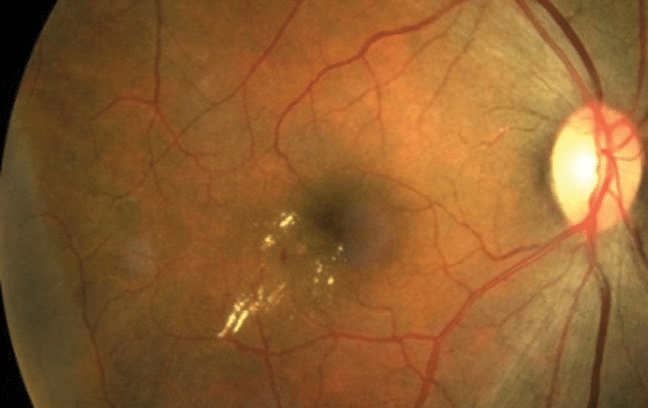Understanding Diabetic Macular Edema (DME) in the Context of Diabetes
Diabetes presents numerous complications, and among the most severe is diabetic macular edema (DME). This condition poses a significant threat to vision, emerging as the primary cause of preventable blindness in adults grappling with diabetes.
To navigate the complexities of DME and its management, a comprehensive understanding of its origins, impact, and evolving treatment landscape becomes imperative.
Tip: Please fill out the form if you or a friend would like more information on CGM devices.
Delving Deeper into DME: Pathways and Consequences
At its core, DME is an outcome of diabetic retinopathy, the consequence of prolonged exposure to elevated glucose levels that inflict damage on the delicate blood vessels within the retina.
Over time, this damage results in fluid leakage into the retinal tissue, leading to swelling, particularly in the macula—the critical region for central and detailed vision.
The clinical urgency surrounding Diabetic Macular Edema stems from its propensity to cause significant visual impairment and, if left untreated, eventual blindness.
For individuals managing diabetes, the specter of DME underscores the importance of vigilance and proactive care in preserving vision health.
Read Guide about Wegovy Dosage Guide: The Best Way For Weight Loss
Current Treatment Modalities for Diabetic Macular Edema: A Multifaceted Approach
The contemporary arsenal against DME encompasses an array of therapeutic strategies, each aiming to alleviate symptoms, impede disease progression, and safeguard vision.
From anti-VEGF (vascular endothelial growth factor) injections to steroid implants, NSAID eye drops, and laser therapies, clinicians employ diverse approaches tailored to individual patient needs.
Anti-VEGF drugs, including Avastin, Lucentis, and Eylea, occupy a pivotal position in Diabetic Macular Edema management.
By targeting the aberrant growth of blood vessels and mitigating fluid leakage, these medications offer substantial promise in preserving visual acuity.
However, their efficacy often necessitates regular injections, presenting logistical challenges and potential barriers to consistent care for patients.
Emerging Paradigms in DME Treatment: Paving the Way for Optimized Care
In recent years, the landscape of DME treatment has witnessed remarkable advancements, signaling a paradigm shift toward enhanced efficacy and reduced treatment burden.
Notable among these innovations are medications like Vabysmo and high-dose Eylea, heralding longer intervals between injections.
The allure of extended-duration therapies lies not only in their potential to ameliorate the inconvenience of frequent clinic visits but also in their capacity to cater to patients in remote or underserved regions.
Must Read CGMs in noncritical care hospitals optimizes glycemic control
Navigating Challenges: Accessibility, Affordability, and Treatment Adherence
While the advent of extended-duration therapies holds immense promise, ensuring equitable access and affordability remains a pivotal concern.
The disparity in access to advanced treatments among diverse socio-economic strata underscores the urgent need for measures to democratize care.
Addressing these challenges is pivotal to ensure that all individuals grappling with Diabetic Macular Edema can avail themselves of the latest therapeutic innovations without undue financial strain.
Moreover, the transition to non-invasive alternatives, such as Oculis’ eye drops and Vantage Biosciences’ oral drug VX-01, introduces a fresh set of considerations.
While these avenues present a departure from conventional injection-based treatments, challenges like sustained adherence to eye drop regimens and potential systemic side effects of oral medications demand meticulous attention.
Charting the Course for the Future: Holistic Approaches and Novel Interventions
Looking ahead, the horizon of DME treatment appears promising with ongoing research endeavors delving into gene therapies, aiming to revolutionize the landscape of diabetes-related eye diseases.
These innovative interventions, often involving one-time viral vector injections to stimulate the eye’s intrinsic anti-VEGF production, hold immense potential in offering sustained relief from Diabetic Macular Edema while minimizing the treatment burden.
Simultaneously, a fundamental truth underscores the evolving vista of Diabetic Macular Edema management: prevention remains the linchpin. A significant resonance can be found in the age-old proverb that “prevention is better than cure” when it comes to the eye health that is associated with diabetes.
Early detection through vigilant screening, coupled with intensive interventions at the onset, can potentially avert the need for invasive procedures and forestall irreversible vision impairments.
Also, read more about Adult Latent Autoimmune Diabetes (LADA) and Complications
The Crucial Role of Lifestyle and Systemic Management in Vision Health
Beyond pharmacological interventions, the holistic approach to managing Diabetic Macular Edema encompasses optimizing glycemic control and blood pressure levels.
The interplay between systemic health and ocular well-being forms a symbiotic relationship, where meticulous attention to lifestyle factors—such as dietary modifications, regular physical activity, and stress management—plays a pivotal role in preserving vision.
Shifting Paradigms, Alleviating Apprehensions: Reassuring Patients Amid Treatment Evolutions
Understanding the apprehensions and anxieties associated with treatments, healthcare providers are instrumental in assuaging patient concerns.
The assurance of the safety and efficacy of procedures, coupled with empathetic communication, goes a long way in instilling confidence in patients navigating the realms of DME management.
Conclusion: Embracing Progress, Pioneering Change
As the realm of DME treatment continues its trajectory of innovation, the amalgamation of pioneering research, patient-centric care, and equitable accessibility emerges as the crux of transforming the landscape of diabetic eye health.
Each stride toward optimized care and enhanced treatment modalities not only brings hope to individuals battling Diabetic Macular Edema but also signifies a collective commitment to ensuring a future where vision loss due to diabetes becomes a preventable anomaly rather than an inevitable consequence.


